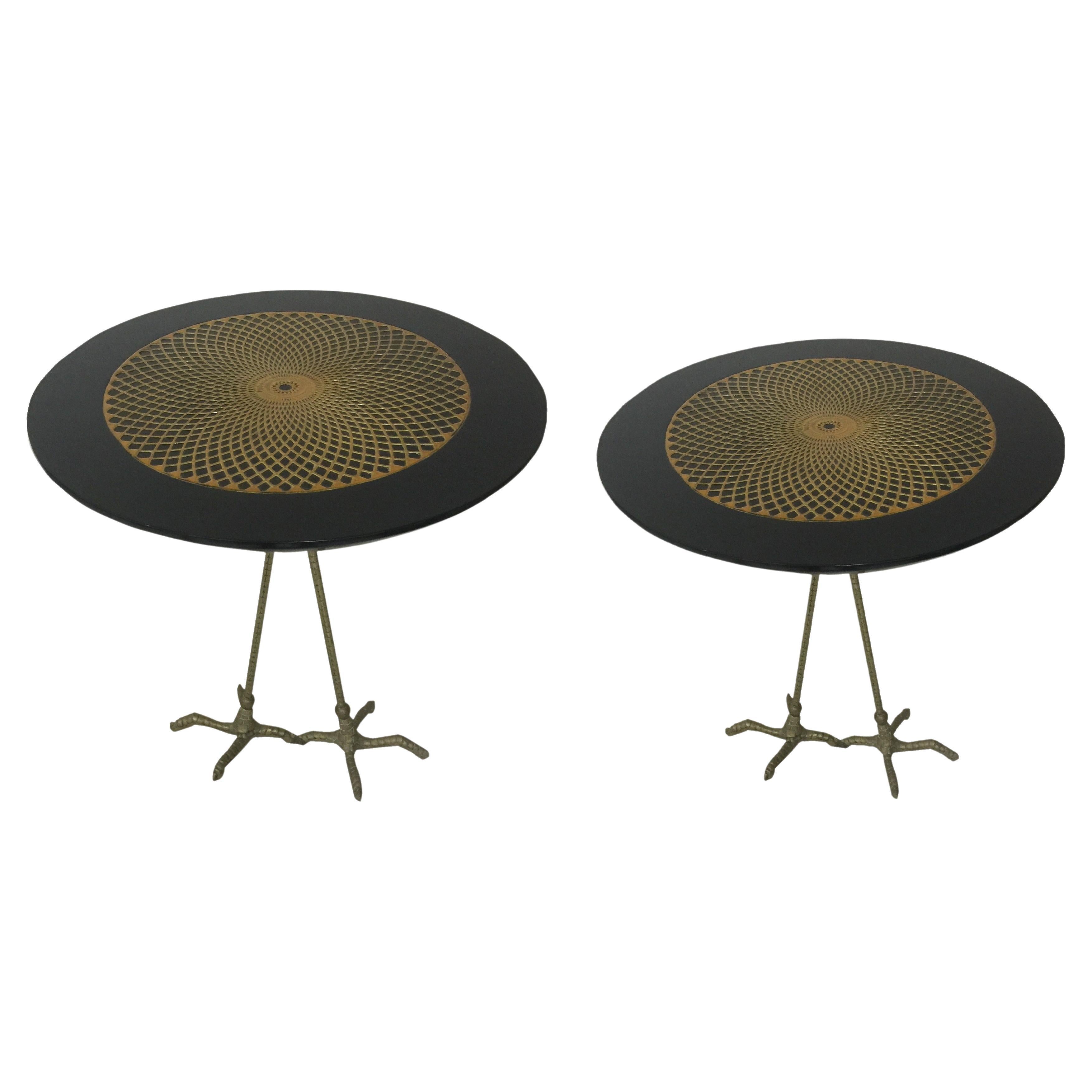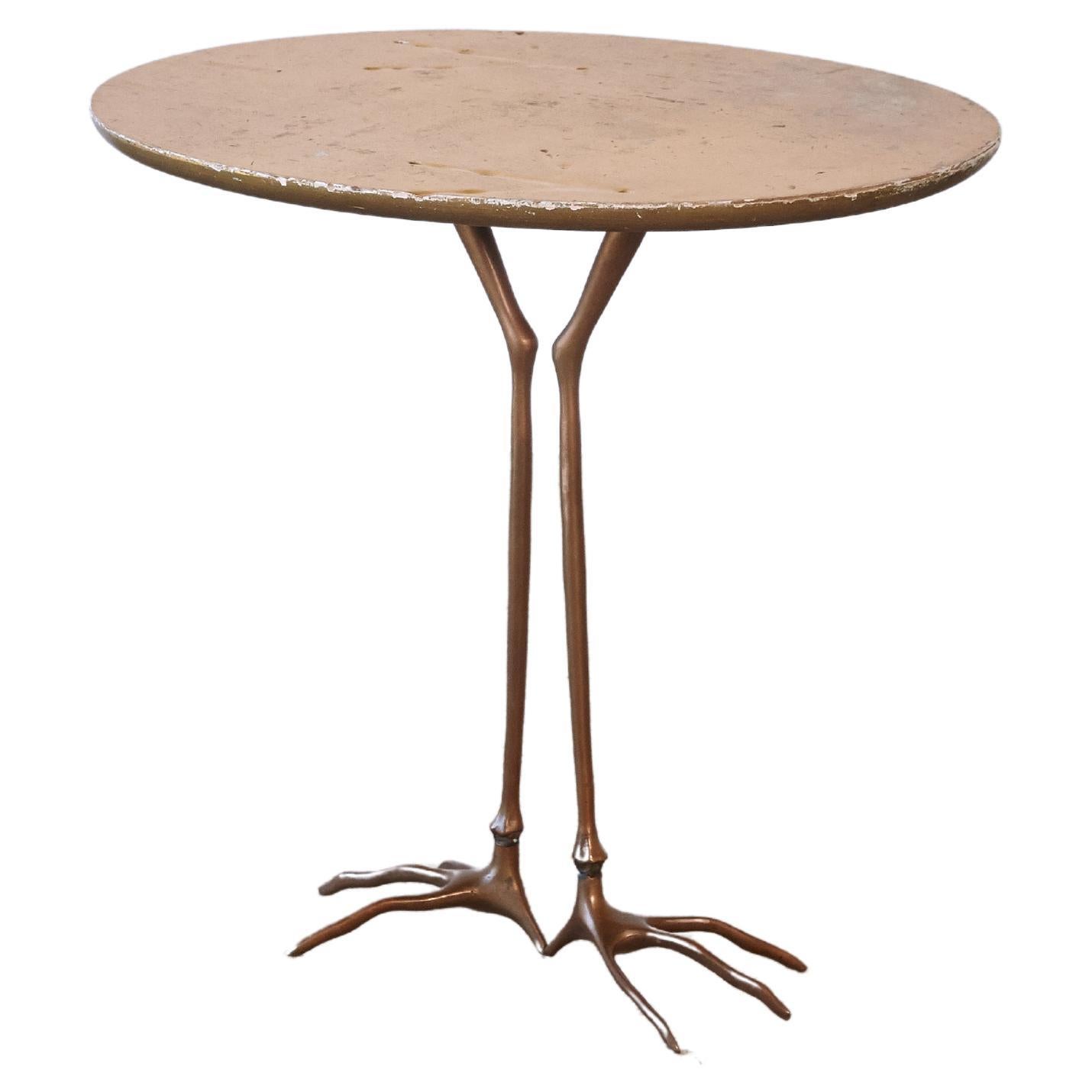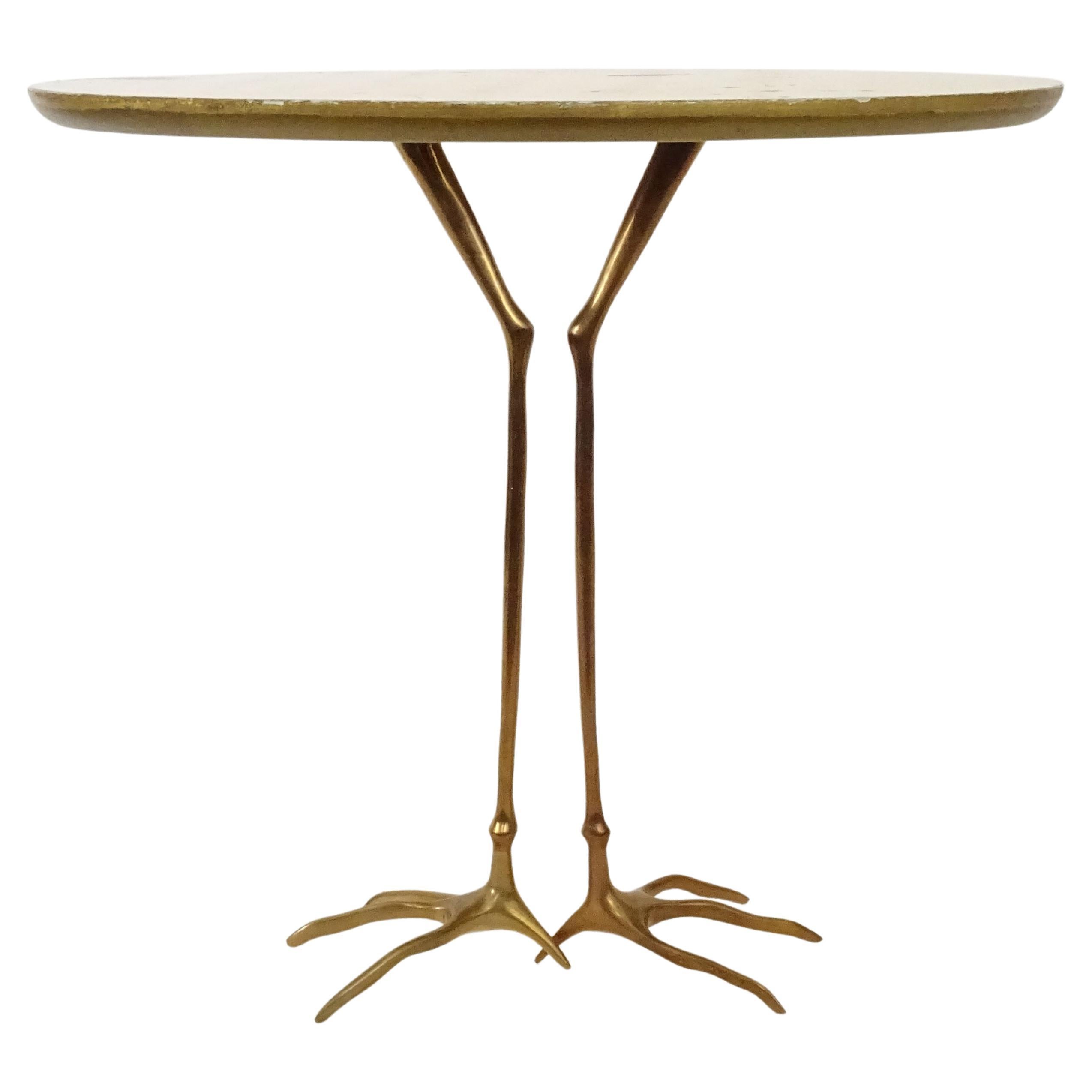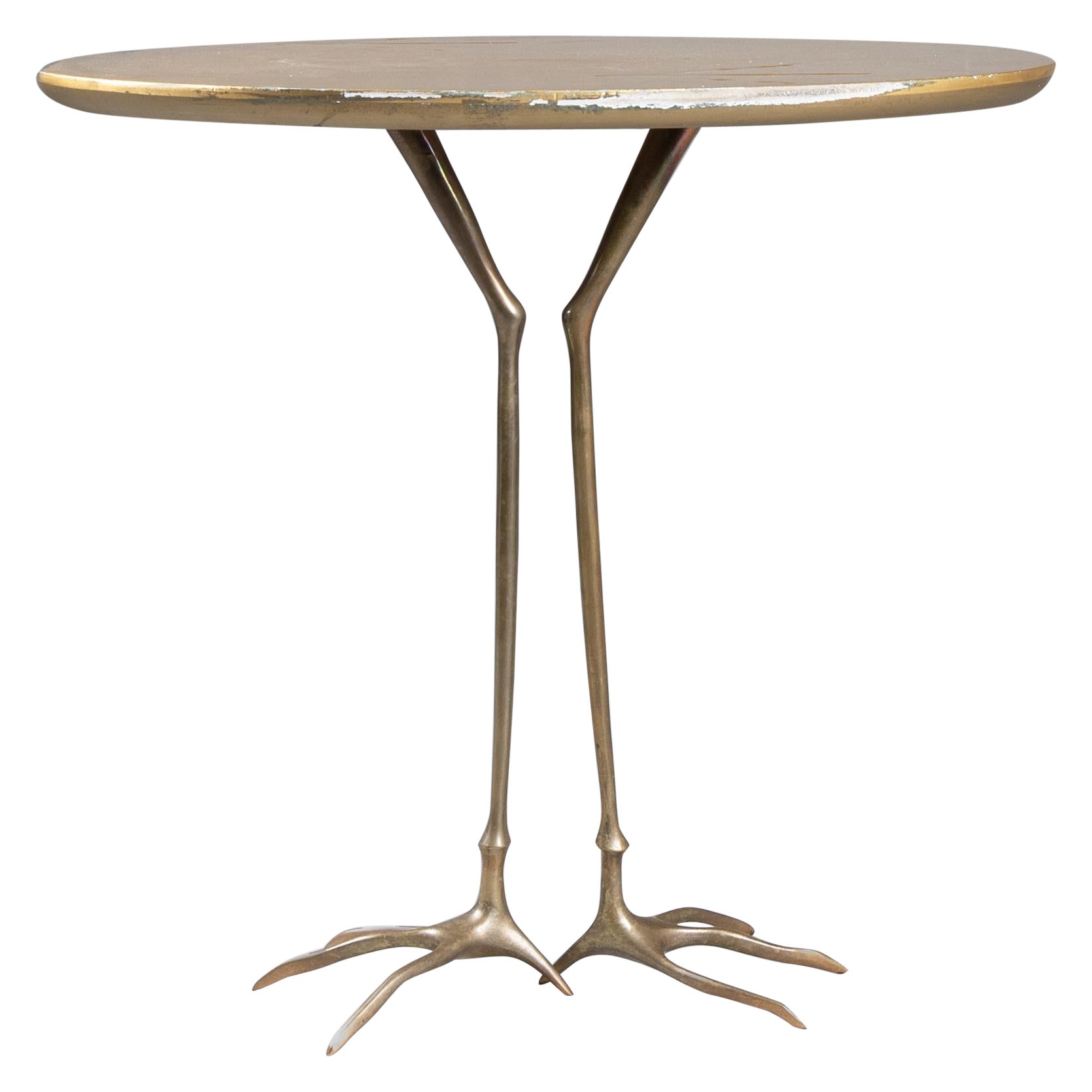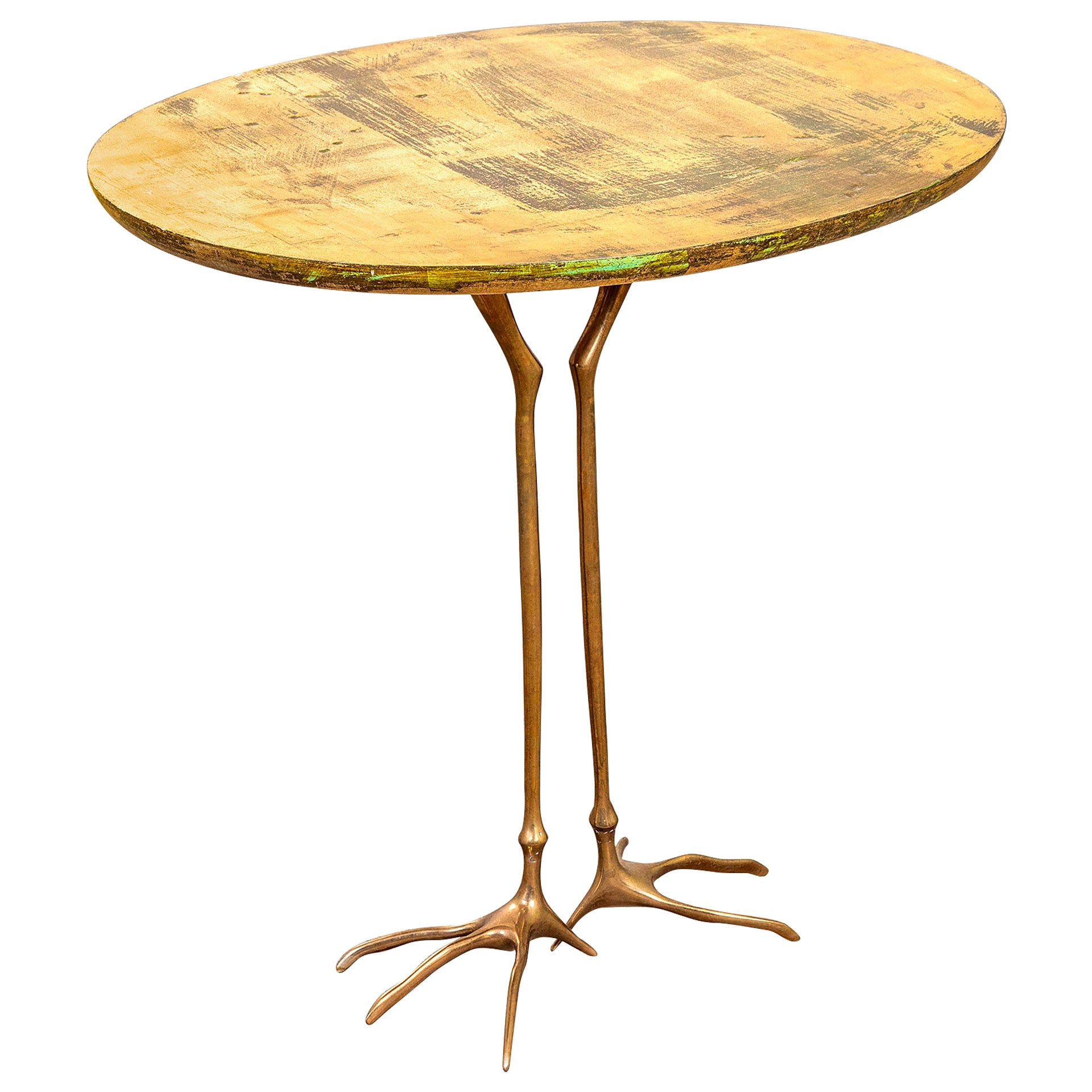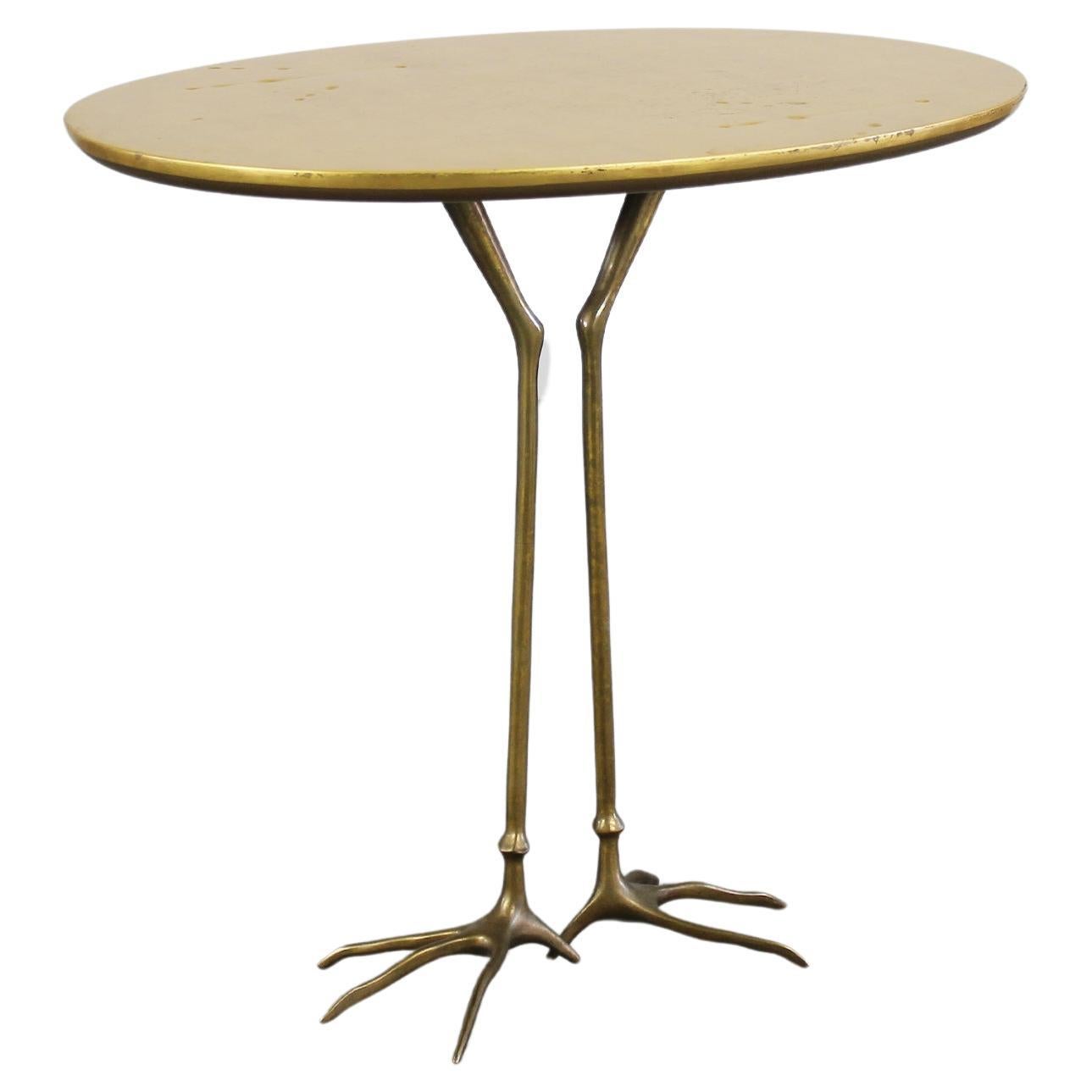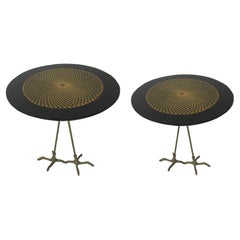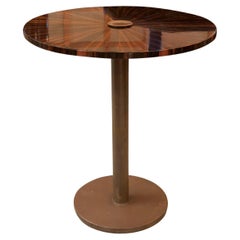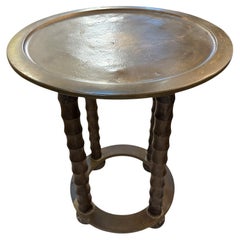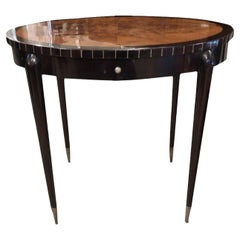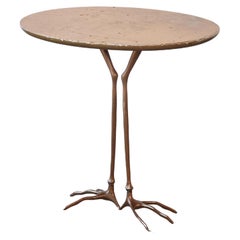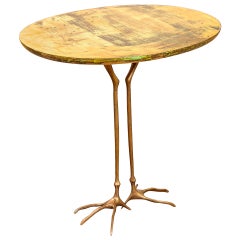Items Similar to Tables in Wood and Bronze Attributed to Meret Oppenheim, France, 1930
Video Loading
Want more images or videos?
Request additional images or videos from the seller
1 of 16
Tables in Wood and Bronze Attributed to Meret Oppenheim, France, 1930
$25,000
£18,673.80
€21,649.30
CA$34,711.88
A$38,907.54
CHF 20,258.02
MX$475,077.75
NOK 257,203.20
SEK 243,805.50
DKK 161,527.20
Shipping
Retrieving quote...The 1stDibs Promise:
Authenticity Guarantee,
Money-Back Guarantee,
24-Hour Cancellation
About the Item
Table
Material: wood and bronze
Style: Art Deco
Country: France
If you want to live in the golden years, this is the tables that your project needs.
We have specialized in the sale of Art Deco and Art Nouveau and Vintage styles since 1982.If you have any questions we are at your disposal.
Pushing the button that reads 'View All From Seller'. And you can see more objects to the style for sale.
Meret Oppenheim
Meret Oppenheim -Traccia Table - The person and the works of German-Swiss artist Meret Oppenheim (1913-1985) are forever associated with surrealism and 20th century art history.
Meret Oppenheim, in full Meret Elisabeth Oppenheim, (born October 6, 1913, Berlin, Germany—died November 15, 1985, Basel, Switzerland), German-born Swiss artist whose fur-covered teacup, saucer, and spoon became an emblem of the Surrealist movement. The piece, created when Oppenheim was just 23 years old, became so famous that it overshadowed the rest of her career.
Oppenheim’s father was German and Jewish and her mother was Swiss. In 1914, at the outbreak of World War I, the family moved from Germany to Switzerland. Oppenheim was encouraged by her father and by her maternal grandmother, author and illustrator Lisa Wenger-Ruutz, to pursue art. Thus, in 1929 she began art studies at the Kunstgewerbeschule in Basel (through 1930). She then moved to Paris and briefly attended the Académie de la Grande Chaumière in 1932.
Being in Paris offered Oppenheim the opportunity to connect with leading avant-garde artists, which, more than schooling, gave her entrée into the art world. In 1933 she met Alberto Giacometti, Man Ray, André Breton, and Jean (Hans) Arp. Oppenheim was quickly absorbed into the Surrealist circle and exhibited three paintings at the Salon des Surindépendants in Paris in 1933. Soon after meeting Man Ray, she became his muse and modeled for images such as Érotique Voilée (1933; “Erotic Veiled”), in which she appeared nude behind a large printing-press wheel, her left forearm and hand covered in black ink and held against her forehead. The image was published in the Surrealist movement’s journal, Minotaure, in 1934. That year she also began a romantic relationship with artist Max Ernst, which lasted just a year. In 1935 Oppenheim participated in international Surrealist exhibitions in Copenhagen and Tenerife, Canary Islands, and then a year later in London and New York.
During the 1930s Oppenheim created assemblages of everyday items, many of which evoked eroticism, such as My Nurse (1936), a pair of women’s high-heeled shoes trussed together like a game fowl, with paper frills (crowns) on the heels, and placed sole-side up on a platter. In 1936 she also created her most famous work of art. After talking casually with Pablo Picasso and Dora Maar in a Paris café about all the mundane things she could cover in fur and turn into art—like the bracelet she had made and was wearing at the time—Oppenheim selected a teacup, saucer, and spoon to cover in Chinese gazelle fur. The result, Object, was part of the first Surrealist exhibition held at New York’s Museum of Modern Art (MoMA), “Fantastic Art, Dada, Surrealism,” curated by Alfred H. Barr, Jr., in 1936, and it became an overnight art world sensation. MoMA then acquired Object, the museum’s first acquisition (in the seven years since its founding) of art made by a woman. Breton later named the assemblage Le Déjeuner en fourrure (“Luncheon in Fur”), in a nod to Edouard Manet’s iconic painting Le Déjeuner sur l’herbe (1863; “Luncheon on the Grass”) and Austrian writer Leopold von Sacher-Masoch’s erotic novella Venus en fourrures (1870; original title Venus im Pelz; “Venus in Furs”). Reaping the rewards of her newfound fame, Oppenheim had her first solo exhibition in 1936 at Galerie Marguerite Schulthess in Basel.
In 1937 Oppenheim returned to Basel and enrolled in vocational school for two years to study art conservation and restoration, skills she planned to use to earn a living. Overwhelmed by the sensation caused by Object, Oppenheim retreated from the Surrealists. Also frustrated and fearful of the constraints that her early success would put on her developing artistic career, she sank into a deep depression and creative crisis that lasted nearly two decades.
By her own account, she “recovered [her] pleasure in making art very suddenly in late 1954” and rented her own studio in Bern, Switzerland. During that period she also began writing and branching out into other forms of creative production. She created costumes for a production by Daniel Spoerri of Picasso’s play Le Désir attrapé par la queue (1956; Desire Caught by the Tail). In 1959 she created a performance piece for a group of close friends in Bern: Spring Feast (“Frühlingsfest”), an elaborate banquet that Oppenheim served (without silverware) on the body of a nude woman laid out on a long table. Breton asked her to reproduce the piece for the Exposition inteRnatiOnale du Surréalisme (EROS) in Paris (1959–60). Though she did participate, she was not pleased when her work was criticized for objectifying women, as her intention had been to reflect the spring abundance offered from Mother Earth. She never exhibited with the Surrealists again.
In 1967 Oppenheim was recognized with a large retrospective in Stockholm. Her work was further revived in the 1970s by feminist scholars seeking to reintroduce to art history forgotten women artists. In 1975 she won the Art Award from the city of Basel and in 1982 the Grand Art Prize from the city of Berlin. Over the course of her life, Oppenheim created jewelry, sculpture, paintings, furniture, performance art, and poetry. She also designed several public and private fountains in her later years. The controversial tall stone fountain she designed for a public square in Bern (1983), which trickles water and grows algae and moss, was seen initially as an eyesore by the city’s residents. Exhibitions in the late 20th and early 21st centuries, including retrospectives in New York City (1996; Guggenheim Museum), Bern (2006; Kunstmuseum), and Berlin (2013; Martin-Gropius-Bau), portrayed her not as the Surrealist one-hit wonder that she had become in the 1930s but as a multifaceted artist with a varied and inspired body of work.
Why are there so many antiques in Argentina?
In the 1880 – 1940 there was a grate wave of immigration encouraged by the periods of war that were taking place.
1st World War took place between 1914 and 1918
2nd World War took place between 1939 and 1945
The immigrants options were New York or Buenos Aires. Tickets were cheap and in Buenos Aires they were welcomed with open arms, as it was a country where everything was still to be done.
Argentina was the country of new opportunities, labour was needed and religious freedom was assured, in many cases the of the family travel first until they were settled and then the rest of the family members join them.
In the immigrant museum “Ellis Island Immigrant Building” in New York you can se the promotional posters of the boats that would take them to a new life.
Between the years 1895 and 1896, Argentina had the highest DGP (gross domestic product) per capita in the world according to the Maddison Historical Statistics index, this situation arose due to the large amount of food being exported to European countries, which were at war.
The Argentinean ships left the port of Buenos Aires with food, but they returned with furniture, clothes and construction elements, (it´s common to see this the old buildings of the historic neighbourhood of San Telmo, the beams with the inscription “Made in England)”, as well as many markets that were built in Buenos Aires, such us the San Telmo Market, whose structure was brought by ship and afterwards assembled in 900 Defensa Street.
With the great influence of European immigrants living in the country, the children of the upper classes travelled to study in France, resulting in the inauguration of “La Maison Argentinienne”, on 27th of June 1928, in the international city of Paris, which hosted many Argentinians that were studying in Frace.
It´s the fourth house to be built after France, Canada and Belgium, being the first Spanish-speaking one. Still in place today (17 Bd Jourdan, 75014, Paris, France). Many of the children of these wealthy families who attended international art exhibitions, museums and art courses abroad, took a keen interest in the European style. This is why Buenos Aires was at the time referred as “The Paris of South America”.
Between the years 1890 and 1920 more than a hundred Palaces were built on Alvear Avenue the most exclusive avenue in Buenos Aires. Today some of these palaces have been transformed into museums, hotels and embassies.
In the year 1936, the Kavanagh building was inaugurated, it was the tallest reinforced concrete building in South America.
During 1994 the American Society of Civil Engineers distinguished it as an “international engineering milestone”, and it´s now considered a World Heritage of Modern Architecture.
At the time was common to hire foreign architects such as Le Corbusier, who visited Buenos Aires/Argentina in 1929 and in 1948 he drew up the blueprints for a house built in La Plata City (which was declared a World Heritage Site).
In 1947, the Hungarian architect Marcelo Breuer designed “Parador Ariston” in the seaside city of Mar del Plata. After an Argentinean student at Harvard University convinced him to come to Argentina. He worked on an urban development project in the Casa Amarilla, area of La Boca.
The Ukrainian architect, Vladimiro Acosta, arrives in Argentina in 1928 and worked as an architect until que moved to Brazil.
Antonio Bonet, a Spanish architect who worked with Le Corbusier in Paris, arrives in Argentina in 1937, where he carried out several architectural works and in 1938 designs the well-known BFK chair.
Andres Kálnay, of Hungarian origin, made around 120 architectural masterpieces, among which the former Munich brewery stands out, he even made the furniture’s design.
The German architect, Walter Gropius, director of the Bauhaus, lived in Argentina, where he wrote articles for “Sur” magazine and founded in Buenos Aires, an architectural firm with Franz Möller, who was also an architect, where he built two houses.
At the same time several famous designers decided to immigrate to Argentina, among them we can find the well-known French designer, Jean-Michel Frank, who arrived in the country in 1940 and also worked for the Rockefeller family.
Special pieces were made, which were sold exclusively in the country, such as the well-known German company “WMF”, who sold their products by catalogue, which were chosen by the ladies of high society in the list of wedding gifts, as well as the pieces designed by Christofle.
The Swiss sculptor Alberto Giacometti, made special pieces for Argentinean mansions.
In 1904 the first Jansen branch outside Paris was established in Buenos Aires, as the Argentinean clientele demanded a large amount of furniture, from the end of the 19th century to the mid-20th century.
In 1970, the brand Rigolleau Argentina made pieces authorised by Lalique.
The brands Maple and Thompson also set up shop in the country.
The French plastic artist, Marcel Duchamp moved to Argentina in 1918-1919.
Glass signed Gallé, Charder, Leverre, Schneider, Muller and other French firms. They were bought in flower shops and were given to ladies with beautiful floral arrangements.
Some furniture manufacturers travelled to international fairs and bough the patterns to produce the furniture in Argentina, such as the furniture firm Englander and Bonta, who bought the patterns ins Italy.
It is worth mentioning that in Argentina we have the largest community of Italians outside of Italy, as it is estimated that 70 percent of the inhabitants have at least one Italian descendant, followed by Spanish immigrants.
The most Important furniture stores in Argentina:
Comte is founded in 1934 (under the direct management of Jean Michel Frank in 1940).
Nordiska (Swedish company established in 1934).
Churba in 1960, a company that brought foreign designers to present their furniture in the country:
Denmark: (Arne Jacobsen, Finn Juhl, Bender Madsen, Ejner Larsen, Poul Kjaerholm, Hans Wegner)
Sweden: (Hans Agne Jakobsson, Gustavsberg)
United States: (Herman Miller)
Finland: (Lisa Johansson, Folke Arstrom, Tapio Wirkkala, Alvar Aalto, Timo Sarpaneva)
Swedish Factory: (Orrefors)
Italy: (Littala, Vico Magistretti, Emma Gismondi, Gae Aulenti, Angelo Mangiarotti, Elio Martinelli, Gianna Celada, Angelo Mangiarotti, Mario Bellini, Carlo Scarpa)
Finland: (Olivia Toikka)
Plata Lappas (Lappas Silver): a goldsmith shop founded in 1887 in Argentina by Alcibiades Lappas of Greek origin.
In 2019, in Argentina took place “the Art Deco world congress”, in which we participated as hosts invited by Geo Darder, founder of the Copperbridge – Foundation, in which prominent people from all over the world attended to learn about Art Deco in Argentina.
Argentina currently has more than 100 Art Deco buildings and another 90 Art Nouveau buildings throughout the city of Buenos Aires.
Argentina is a country that has not been involved in many wars, which is why it has been a refuge for works of art and antiques from different periods of time, unlike European countries. That is way many collectors, museums and antique dealers from all over the world visit it, you should not miss the opportunity to visit this great country.
Laura Guevara Kjuder, architect.
- Attributed to:Meret Oppenheim (Artist)
- Dimensions:Height: 23 in (58.4 cm)Diameter: 20.87 in (53 cm)
- Style:Art Deco (Of the Period)
- Materials and Techniques:Bronze,Wood
- Place of Origin:France
- Period:1930-1939
- Date of Manufacture:1930
- Condition:Wear consistent with age and use.
- Seller Location:Ciudad Autónoma Buenos Aires, AR
- Reference Number:Seller: F-CO-2091stDibs: LU6785231678302
About the Seller
5.0
Vetted Professional Seller
Every seller passes strict standards for authenticity and reliability
Established in 1982
1stDibs seller since 2022
36 sales on 1stDibs
Typical response time: <1 hour
- ShippingRetrieving quote...Shipping from: Ciudad Autónoma Buenos Aires, Argentina
- Return Policy
Authenticity Guarantee
In the unlikely event there’s an issue with an item’s authenticity, contact us within 1 year for a full refund. DetailsMoney-Back Guarantee
If your item is not as described, is damaged in transit, or does not arrive, contact us within 7 days for a full refund. Details24-Hour Cancellation
You have a 24-hour grace period in which to reconsider your purchase, with no questions asked.Vetted Professional Sellers
Our world-class sellers must adhere to strict standards for service and quality, maintaining the integrity of our listings.Price-Match Guarantee
If you find that a seller listed the same item for a lower price elsewhere, we’ll match it.Trusted Global Delivery
Our best-in-class carrier network provides specialized shipping options worldwide, including custom delivery.More From This Seller
View AllUnusual 2 Tables in wood and bronze Attributed to Meret Oppenheim, France, 1930
By Meret Oppenheim
Located in Ciudad Autónoma Buenos Aires, C
The two tables have different heights
Material: wood and bronze
Style: Art Deco
Country: France
If you want to live in the golden years, this is the tables that your project needs.
We have specialized in the sale of Art Deco and Art Nouveau and Vintage styles since 1982.If you have any questions we are at your disposal.
Pushing the button that reads 'View All From Seller'. And you can see more objects to the style for sale.
Meret Oppenheim
Meret Oppenheim -Traccia Table - The person and the works of German-Swiss artist Meret Oppenheim (1913-1985) are forever associated with surrealism and 20th century art history.
Meret Oppenheim, in full Meret Elisabeth Oppenheim, (born October 6, 1913, Berlin, Germany—died November 15, 1985, Basel, Switzerland), German-born Swiss artist whose fur-covered teacup, saucer, and spoon became an emblem of the Surrealist movement. The piece, created when Oppenheim was just 23 years old, became so famous that it overshadowed the rest of her career.
Oppenheim’s father was German and Jewish and her mother was Swiss. In 1914, at the outbreak of World War I, the family moved from Germany to Switzerland. Oppenheim was encouraged by her father and by her maternal grandmother, author and illustrator Lisa Wenger-Ruutz, to pursue art. Thus, in 1929 she began art studies at the Kunstgewerbeschule in Basel (through 1930). She then moved to Paris and briefly attended the Académie de la Grande Chaumière in 1932.
Being in Paris offered Oppenheim the opportunity to connect with leading avant-garde artists, which, more than schooling, gave her entrée into the art world. In 1933 she met Alberto Giacometti, Man Ray, André Breton, and Jean (Hans) Arp. Oppenheim was quickly absorbed into the Surrealist circle and exhibited three paintings at the Salon des Surindépendants in Paris in 1933. Soon after meeting Man Ray, she became his muse and modeled for images such as Érotique Voilée (1933; “Erotic Veiled”), in which she appeared nude behind...
Category
Vintage 1930s French Art Deco Tables
Materials
Bronze
Art Deco Table, France, 1930, Material : Wood and Bronze
Located in Ciudad Autónoma Buenos Aires, C
Table
Material: Wood and bronze
Style: Art Deco
France.
We have specialized in the sale of Art Deco and Art Nouveau styles since 1982.If you have any questions we are at your dispos...
Category
Vintage 1930s French Art Deco Serving Tables
Materials
Bronze
Table Viennese Secession, 1900, Wood and Bronze
Located in Ciudad Autónoma Buenos Aires, C
Table vienna Secession
Material: wood and bronze
Style: Vienna Secession
Country: Vienna
We have specialized in the sale of Art Deco and Art Nouveau and Vintage styles since 1982. If...
Category
Antique Early 1900s Austrian Vienna Secession Tables
Materials
Bronze
Table with Drawer in Wood and Silver Plated Bronze, 1920, France
Located in Ciudad Autónoma Buenos Aires, C
Table
Material: Wood and silver plated bronze
France
We have specialized in the sale of Art Deco and Art Nouveau and Vintage styles since 1982. If you have any questions we are at yo...
Category
Vintage 1920s French Art Deco Dessert Tables and Tilt-top Tables
Materials
Wood
Table in wood and silver plated, 1930, France
Located in Ciudad Autónoma Buenos Aires, C
Table
Material: wood and silver plated
France
We have specialized in the sale of Art Deco and Art Nouveau and Vintage styles since 1982. If you have any questions we are at your di...
Category
Vintage 1930s French Art Deco Coffee and Cocktail Tables
Materials
Wood
$5,200 / item
Table Art Deco in Wood and chrome bronze, 1920, France
Located in Ciudad Autónoma Buenos Aires, C
Material: wood and chrome bronze
Style: Art Deco
Country: France
If you want to live in the golden years, this is the tables that your project needs.
We have specialized in the sale ...
Category
Vintage 1920s French Art Deco Tables
Materials
Chrome
You May Also Like
Original 1970s Production Meret Oppenheim Traccia Table, Gavina, Italy
By Meret Oppenheim
Located in LEWES, GB
An original and authentic Meret Oppenheim Traccia table. This table manufactured by Gavina, Italy as part of the initial production in th...
Category
Vintage 1970s Italian Mid-Century Modern Side Tables
Materials
Bronze, Gold Leaf
Early Meret Oppenheim Traccia Side Table for Simon Gavina, Italy 1972
By Meret Oppenheim, Simon Gavina Editions
Located in Milan, IT
Meret Oppenheim Traccia side table by Simon Gavina 1972
Designed by Meret Oppenheim in 1939 and produced by Simon Gavina in 1972
Gold leaf wood...
Category
Vintage 1980s Italian Mid-Century Modern Side Tables
Materials
Bronze, Gold Leaf
Traccia coffee table by Meret Oppenheim for Simon, 1972
By Meret Oppenheim
Located in Milano, Lombardia
Traccia Coffee Table, Meret Oppenheim, Simon, Italy, 1972
Iconic Surrealist coffee table with oval top made of embossed gold plate, supported by two cast bronze bird feet. Designed...
Category
Vintage 1970s Italian Post-Modern End Tables
Materials
Bronze, Sheet Metal
20th Century Meret Oppenheim Traccia Side Table by Simon Gavina Golden '70s
By Meret Oppenheim, Simon Gavina Editions
Located in Turin, Turin
This table is a surrealist piece of furniture made while International Style was popular. Meret Oppenheim was a German-born Swiss artist and designer best known for her teacup lined ...
Category
Vintage 1970s Italian Mid-Century Modern Center Tables
Materials
Bronze
Meret Oppenheim Traccia Side Table in Wood Gold Leaf and Bronze by Gavina 1980s
By Meret Oppenheim, Simon Gavina Editions
Located in Montecatini Terme, IT
Traccia side table with structure in polished cast bronze, elliptical top in plywood finished with fine yellow gold leaf.
Traccia table was origi...
Category
Vintage 1970s Italian Mid-Century Modern Side Tables
Materials
Bronze, Gold Leaf
Meret Oppenheim Traccia Sculptural Table
By Cassina, Meret Oppenheim
Located in Barcelona, Barcelona
Meret Oppenheim Traccia sculptural table
Manufactured by Cassina in Italy
In 1971, Dino Gavino launched what he called “l’...
Category
2010s Italian Mid-Century Modern Side Tables
Materials
Steel
$6,211 / item
More Ways To Browse
Architect Table French
Avant Garde Table
Antique Architect Tables
Antique Flower Stand Table
1930 Vintage Bracelet
Bronze Giacometti Table
1930 Vintage Costume Jewelry
Circle Of Life Table
Angelo Mangiarotti Bronze Table
Danish Painting Ship
19th Century Bracelet French
German Nodder
Copenhagen Jewellery Vintage
Made In Austria Vintage Jewelry
Dior Brown Shoes
The Leopold Company
Art Deco Jewish
French Grande Poster
